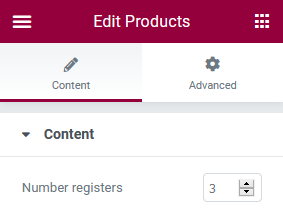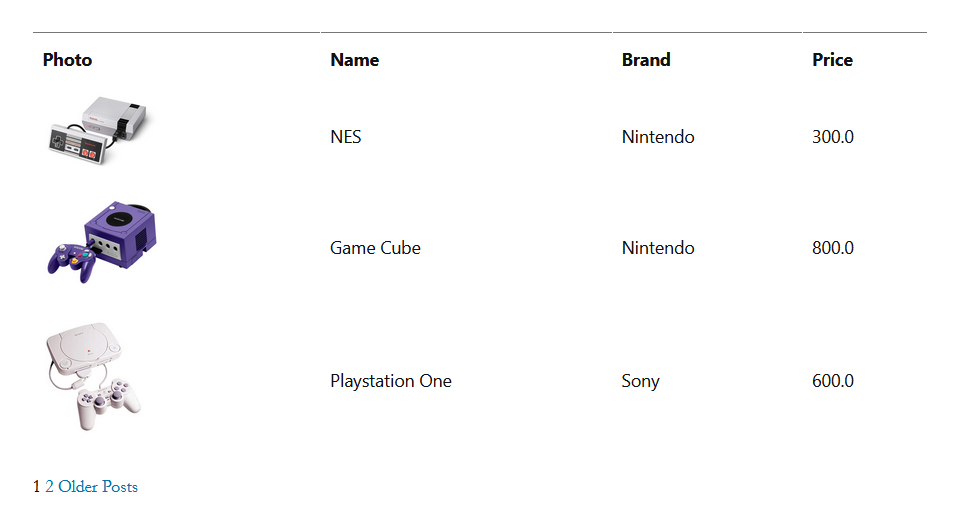Creating Elementor Widgets
The Elementor is a WordPress tool that allows you to build pages dynamically through widgets. It has some widgets but you can make yours. In this article, I will show how to do it. The idea is to create a simple widget to list products and their information.
I will assume you have a WordPress installation with the Elementor plugin active.
In the first step, you need to create a custom post type for products and add custom fields. I like using Advanced Custom Fields to configure fields and associate them with posts type.

To work with Elementor I have a preference to build a plugin to keep the source more organized and using this strategy you can apply in other projects.
To create a plugin, you need to create a directory called elementor-custom-widgets inside wp-content > plugins. This new directory will have the following structure.
> tree /wp-content/plugins/elementor-custom-widgets
| - elementor-custom-widgets.php
| - index.php
| - /widgets
| ---- /products
| -------- index.php
| -------- html.php
| -------- widget.php
The index.php files only contain comments.
<?php // Silence
The elementor-custom-widgets.php file configures the plugin and records widgets.
<?php
/**
* Plugin Name: My Custom Widgets
* Description: My Custom Widgets for Elementor
* Author: Fernando Mariano
* Author URI: https://fndomariano.github.io
*/
namespace MyCustomWidgets;
class Plugin {
public function __construct() {
add_action( 'elementor/widgets/widgets_registered', [ $this, 'register_widgets' ] );
}
private function include_widgets() {
require_once( __DIR__ . '/widgets/products/widget.php' );
}
public function register_widgets() {
$this->include_widgets();
\Elementor\Plugin::instance()->widgets_manager->register_widget_type( new Widgets\Products() );
}
}
new Plugin();
The /widgets/widget.php file is the whole widget’s settings (controls, icon, title).
<?php
namespace MyCustomWidgets\Widgets;
use Elementor\Controls_Manager;
class Products extends \Elementor\Widget_Base {
public function get_name() {
return 'products';
}
public function get_title() {
return __( 'Products' );
}
public function get_icon() {
return 'fa fa-pencil';
}
public function get_categories() {
return [ 'general' ];
}
protected function _register_controls() {
$this->start_controls_section(
'section_content',
[
'label' => 'Content',
]
);
$this->add_control(
'number_registers',
[
'label' => 'Number registers',
'type' => Controls_Manager::NUMBER,
'default' => 5
]
);
$this->end_controls_section();
}
protected function render() {
$this->getHtml();
}
private function getHtml() {
$products = $this->getProducts();
include 'html.php';
}
private function getProducts() {
$settings = $this->get_settings_for_display();
$paged = ( get_query_var( 'paged' ) ) ? get_query_var( 'paged' ) : 1;
$query = new \WP_Query([
'post_type' => 'product',
'post_status' => 'publish',
'posts_per_page' => $settings['number_registers'],
'paged' => $paged
]);
return $query;
}
}
The /widgets/html.php file is HTML structure integrated with $query result.
<?php if ( $products->have_posts() ): ?>
<table>
<thead>
<td><b><?php echo 'Photo' ?></b></td>
<td><b><?php echo 'Name' ?></b></td>
<td><b><?php echo 'Brand' ?></b></td>
<td><b><?php echo 'Price' ?></b></td>
</thead>
<tbody>
<tbody>
<?php while ( $products->have_posts() ) : $products->the_post(); ?>
<?php $photo = get_field('product_photo', get_the_ID()); ?>
<tr>
<td><img src="<?php echo $photo['url'] ?>" width="<?php echo $photo['sizes']['thumbnail-width'] ?>" height="<?php echo $photo['sizes']['thumbnail-height'] ?>" /></td>
<td><?php echo get_the_title() ?></td>
<td><?php echo get_field('product_brand', get_the_ID()) ?></td>
<td><?php echo get_field('product_price', get_the_ID()) ?></td>
</tr>
<?php endwhile; ?>
</tbody>
</tbody>
</table>
<?php
echo paginate_links( [
'base' => str_replace( 999999999, '%#%', esc_url( get_pagenum_link( 999999999 ) ) ),
'total' => $products->max_num_pages,
'current' => max( 1, get_query_var( 'paged' ) ),
'format' => '?paged=%#%',
'prev_next' => true,
'prev_text' => sprintf( '<i></i> %1$s', __( 'Newer Posts', 'text-domain' ) ),
'next_text' => sprintf( '%1$s <i></i>', __( 'Older Posts', 'text-domain' ) ),
]);
?>
<?php else : ?>
<p><?php _e('Sorry, no posts matched your criteria.'); ?></p>
<?php endif; ?>
To apply this widget is necessary to add a new page on WordPress editing with Elementor and search for the word Products.

Drag and drop to put the widget on the page. Also, control allows the definition of many products to show.

If you don’t have products, add some of them and like this will be possible to see the changes in the same moment.

I hope that I could show how easy it is to build an Elementor widget. The codes above are available on my GitHub.
Is there still any doubt? Please let me know! I will be happy to help you.
Wordpress
Elementor
Widgets
Discussion and feedback